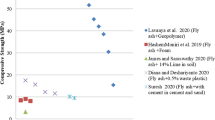Abstract
Bricks have been regarded as one of the most durable and strongest building materials used throughout history. In this study, an attempt has been made to study the behavior of bricks manufactured using waste material like paper industry waste sludge. The objective of this work is to study the stabilization and solidification of industry sludge and then to study the engineering behavior of brick made from it. This paper presents an experimental investigation performed to check the feasibility of using paper sludge waste to reduce the quantity of clay, as there is a greater shortage of clay in many parts of the world. To begin, XRF characterization of paper sludge has been carried out. The bricks were prepared by paper sludge with varying compositions, with reduced quantity of clay from 10 to 50%. After performing various tests, it has been observed that these waste material bricks are lightweighted, sound, corrosion resistant, and strong in compression.
Access this chapter
Tax calculation will be finalised at checkout
Purchases are for personal use only
Similar content being viewed by others
References
Pitroda J, Zala LB, Umrigar FS (2013) Innovative use of paper industry waste (hypo sludge) in design mix concrete. Int J Adv Eng Technol IJAET IV(I):31–35
Srinivasan R, Sathiya K, Palanisamy M (2010) Experimental investigation in developing low cost concrete from paper industry waste. Bull Inst Polytech
Solanki JV, Pitroda J (2013) Study of modulus of elasticity of concrete with partial replacement of cement by hypo sludge waste from paper industry. Glob Res Anal 2(1). ISSN 2277–8160
Balwaik SA, Raut SP (2011) The use of paper-mill pulp in concrete formulations. Int J Eng Res Appl (IJERA) 717–725
Acknowledgements
Authors are thankful to the Himachal Pradesh State Council of Science Technology and Environment for providing the financial assistance to carry out this research.
Author information
Authors and Affiliations
Corresponding author
Editor information
Editors and Affiliations
Rights and permissions
Copyright information
© 2020 Springer Nature Singapore Pte Ltd.
About this paper
Cite this paper
Bhushan, B., Grover, U., John, S., Kanwar, V.S. (2020). Feasibility of Using Paper Industry Sludge Containing Calcium Carbonate in Manufacturing Bricks. In: Shukla, S., Barai, S., Mehta, A. (eds) Advances in Sustainable Construction Materials and Geotechnical Engineering. Lecture Notes in Civil Engineering , vol 35. Springer, Singapore. https://doi.org/10.1007/978-981-13-7480-7_2
Download citation
DOI: https://doi.org/10.1007/978-981-13-7480-7_2
Published:
Publisher Name: Springer, Singapore
Print ISBN: 978-981-13-7479-1
Online ISBN: 978-981-13-7480-7
eBook Packages: EngineeringEngineering (R0)




